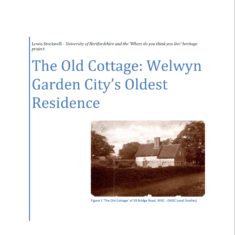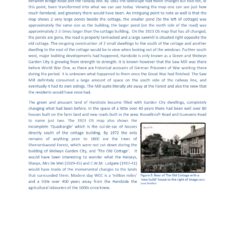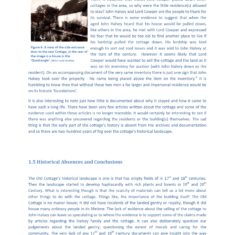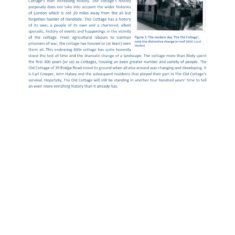The Old Cottage
Welwyn Garden City's Oldest Residence
By Lewis Stockwell
The History of the Old Cottage of Welwyn Garden City
Please Note: You can copy and paste the images below on to your computer to see the original document.
The Old Cottage
There are now thousands of houses that stand in Welwyn Garden City, many of them built by the Welwyn Garden City Company during the first quarter of the 20th Century. There are only a handful of residences that predate the building of WGC; even fewer residences predate the turn of the 19th Century. What is even more intriguing is that ‘The Old Cottage’ was built at the very start of the 17th Century – in 1604 and it still stands in the very same spot as four hundred (and a little more) years ago. This is unlike some of the other ‘historical cottages in the area where they have been pulled down, or moved brick-by-brick to other destinations. In this short history you will be taken through the historical evidence that has been uncovered. From the research, this short history will give you more information about the cottage through the four-hundred years of its life.
1.1 In the Beginning
One of the most surprising things that have been uncovered (or should I say ‘not uncovered’) is the lack of any 17th or even 18th century documents that are connected with ‘The Old Cottage’. As the cottage is such a small residence it is very hard to find traces of it on maps, however with a little ‘digging’ it was possible to find one of the earliest references to ‘Handside’ in a Thomas Kitchin map. This was dedicated to Earl Cowper in 1749 and specifically showed Lemsford Mill. Though there is very little evidence to suggest otherwise, it is possible to confidently place the building date of ‘The Old Cottage’. When renovation work was in progress during the 20th century, coins were found dating from the period. It was refreshing to find at least one early document [The 1749 Tithe map] as well which showed Handside. It was situated close to Lower-Handside farm, and there is later evidence that the Old Cottage was lived in by agricultural labourers. This would fit in with the geography of the landscape as the cottage would have been surrounded by fields and a forest for nearly 300 years until Welwyn Garden City was built.
Before WGC was built however, there is evidence of a rich, vibrant and changing history through the first 300 years of The Old Cottage’s life in Handside. There are sources to suggest that the parishes surrounding this little and insignificant hamlet could not decide who was in charge. Accounts show the parishes of Welwyn and Digswell attempting to sort their differences out over who was in charge of what. It appears that this was done in vain however as the hamlet was to become ‘the northern most point of the parish of Bishops Hatfield’. What is certain though is the long term ownership of the cottage. Tithe maps of the parishes and local villages and towns tend to be dedicated to the owners of the land surveyed. The Maps show that the land had been in the possession of the Cowper family for generations. This ceased when the final Lord Cowper sold his lands, and some of his possessions at auction. Most of the land was bought by the WGCC in the early 20th Century.
1.2 ‘The Old Cottage or The Old Cottages’
Figure 2: ‘The Old Cottage’ – It is possible to make out two separate roofs that might indicate two separate cottages. (WGC Local Studies)[On Original Document]
Although ‘The Old Cottage’ has been written about in many local history books, and appears in published articles, there is hardly any evidence for or against its existence. One of the only types of evidence to suggest The Old Cottage was indeed Cottages is the ‘mishmash’ of censuses and directories. It is possible to list nearly everyone who lived in the cottage from 1841 but it is possible that the censuses do not capture everyone correctly (for instance those people who are not in their houses on census day). That said they do give an indication of the number living in The Cottage. In 1841 there were 12 residents. Now if those 12 people were living in half of the cottage building known today, though a ‘tight-squeeze’, unhealthy and unhygienic, this would still fit in with the overall living standards of the mid-19th century. 5 of the residents of the cottage in 1841 were children one of them only 1 year old and the rest were classed as adults (being 13 and above).
Tony Rook (2001) suggests, without any hesitation that the building is a ‘pair of Cowper cottages’ and Richard Busby (1976) suggests the same. This history is not easily traceable because the historical sources have their limitations and some of authors do not provide references.. That said, evidence from the censuses, parish records, WGC directories, articles and books, suggests that for some period of time prior to 1925 the cottage building could quite probably have been two very ‘cosy’ residences. It would also explain the double chimney of the cottage itself, and the two-section roof which indicated two residences. This is a key indication to there being two cottages rather than one cottage – the two entrances/exits to the building also confirm this. For such a small 17th Century building to have two does appear excessive, even if the cottage was one residence it would still probably have had only one door.
The time which is particularly hard to decipher is the period from 1890 to 1925. The Victorians started to become more and more obsessed with documentation so more documents are available. Why then is there such difficulty in finding ‘hard’ Figure 3: 1841 Census from the Parish of Bishops Hatfield/Northern most point of Handside. The Residence of one of the cottages can be seen here. Note that Mahalath Halsey has been notes as a male and in-fact was female (WGC Local Studies)[On Original Document]
evidence to know who lived in the cottage/cottages at the time? In 1890 Miss C.B. Sharp and Miss M. Sharp are recorded as residents, in 1901-19 John Halsey were known to be living there as well, but in 1925-28 Misses C.B & M. Sharp are still recorded to be living in their Cottage. It is probable then that the building was two cottages, and at some point, probably during the building of WGC, the cottage had major building works and was possibly named ‘The Old Cottage’. The reason for the change in the cottage would have been to fit in with the modern living standards the Welwyn Garden City Company were presenting with their spacious new houses. It would have been illegal to pull the cottage down, and it is obviously much nicer to have a larger space to inhabit without destroying the cottage’s ‘character’. The improvement in overall living standards would also have fitted in with Ebenezer Howard’s philosophy on living standards.
1.3 A Changing Landscape
Figure 4: ‘The Old Cottages’ facing east on Bridge Road, note the two ponds on both sides of the road. (WGC Local Studies)[On Original Document]
It is well known that Welwyn Garden City was constructed in the early 20th century in order to improve the standard of living for the average working person. Ebenezer Howard was certainly onto something when he proved that Letchworth Garden City would be a town like no other. His construction of the second garden city was not Letchworth however and Welwyn Garden City has always had a character of its own. The landscape changed between the 19th and 20th Centuries. Using just three maps showing exactly the same area of Upper-Handside (OS Map dating 1881, OS Map dating 1923 and an OS Map dating 1972) shows a 91 year period of monumental change for the area of the cottages. It presents the growth of business, production, and commerce.
The Luton, Dunstable and Welwyn railway branch line opened in 1858 and this was most certainly one of biggest changes the residents of the cottages would have seen until the building of WGC. Sherrardswood forest was sliced by the railway’s presence but still serves served as a visual barrier between Bridge Road and the railway line. By 1881 the landscape had minor changes but had not, at this point, been transformed into what we can see today. Viewing the map one can see just how much farmland, and greenery there would have been. An intriguing point to note as well is that the map shows 2 very large ponds beside the cottage, the smaller pond (to the left of cottage) was approximately the same size as the building, the larger pond (on the north side of the road) was approximately 2-3 times larger than the cottage building. On the 1923 OS map that has all changed, the ponds are gone, the road is properly tarmacked and a large sawmill is situated right opposite the old cottage. The on-going construction of 2 small dwellings to the south of the cottage and another dwelling to the east of the cottage would be in view when looking out of the windows. Further south west, major building developments had happened, Handside is only known as a Green and Welwyn Garden City is growing from strength to strength. It is known however that the Saw Mill was there before World War One, as there are historical accounts of German Prisoners of War working there during the period. It is unknown what happened to them once the Great War had finished. The Saw Mill definitely consumed a large amount of space on the south side of the railway line, and eventually it had its own sidings. The Mill quite literally ate away at the Forest and also the view that the residents would have once had.
Figure 5: Rear of The Old Cottage with a ‘new build’ house to the right of image (WGC Local Studies)[On Original Document]
The green and pleasant land of Handside became filled with Garden City dwellings, completely changing what had been before. In the space of a little over 40 years there had been well over 80 houses built on the farm land and new roads built in the area: Russellcroft Road and Guessens Road to name just two. The 1923 OS map also shows the incomplete ‘Quadrangle’ which is the cul-de-sac of houses directly south of the cottage building. By 1972 the only remains of anything prior to 1800 are the trees of Sherrardswood Forest, which were not cut down during the building of Welwyn Garden City, and ‘The Old Cottage’. It would have been interesting to wonder what the Halseys, Sharps, Mrs De Wet (1929-35) and C.W.M. Ludgate (1937-41) would have made of the monumental changes to the lands that surrounded them. Modern day WGC is a ‘million miles’ and a little over 400 years away from the Handside the agricultural labourers of the 1600s once knew.
1.4 How did it survive?
Figure 6: A view of the side entrance door to the rear Cottage, in the rear of the image is a house in the ‘Quadrangle’. (WGC Local Studies)[On Original Document]
There is evidence that shows Lord Cowper pulled down other cottages in the area, so why were the little residence(s) allowed to stay? John Halsey and Lord Cowper are the people to thank for its survival. There is some evidence to suggest that when the aged John Halsey heard that his house would be pulled down, like others in the area, he met with Lord Cowper and expressed his fear that he would be too old to find another place to live if his lordship pulled the cottage down. His lordship was kind enough to sort out roof issues and it was sold to John Halsey at the turn of the century. However it seems likely that Lord Cowper would have wanted to sell the cottage and the land as it was on his inventory for auction (with John Halsey down as the resident). On an accompanying document of the very same inventory there is just one sign that John Halsey took over the property – his name being placed above the item on the inventory. It is humbling to know then that without these two men a far larger and impersonal residence would be on its historic ‘foundations’.
It is also interesting to note just how little is documented about why it stayed and how it came to have such a long life. There have been very few articles written about the cottage and some of the evidence used within those articles is no longer traceable. It would certainly be interesting to see if there was anything else uncovered regarding the residents or the building(s) themselves. The sad thing is that the early part of the cottage’s history is absent from the archives and documentation and so there are two-hundred years of fog over the cottage’s historical landscape.
1.5 Historical Absences and Conclusions
The Old Cottage’s historical landscape is one is that has empty fields of in 17th and 18th centuries. Then the landscape started to develop haphazardly with rich plants and forests in 19th and 20th Century. What is interesting though is that the scarcity of materials can tell us a lot more about other things to do with the cottage. Things like, the importance of the building itself: The Old Cottage is no manor house; it did not have residents of the landed gentry or royalty, though it did house many ordinary people in its lifetime. The lack of evidence about the selling of the cottage to John Halsey can leave us speculating as to where the evidence is to support some of the claims made by articles regarding the Halsey family and the cottage. It can also deliberately question our judgements about the landed gentry; questioning the extent of morals and caring for the community. The very lack of any 17th and 18th Century documents can give insight into the way people kept records of their lives and property. It can also show what was important to the people of the day – keeping a track of their daily lives was not important. Agricultural labourers, if those were the types of people living there during the 17th and 18th centuries, might not be able to read or write. Figure 7: The modern day ‘The Old Cottage’, note the distinctive change in roof (WGC Local Studies)[On Original Document]
Although there are quite a few absences of historical detail with The Old Cottage’s history, vibrant and thought provoking histories do emerge from this Cottage’s ever increasing history. The cottage’s history purposely does not take into account the wider histories of London which is not 20 miles away from the all but forgotten hamlet of Handside. This Cottage has a history of its own, a people of its own and a chartered, albeit sporadic, history of events and happenings in the vicinity of the cottage. From agricultural labours to German prisoners of war, the cottage has housed or (at least) seen them all. This endearing little cottage has quite honestly stood the test of time and the dramatic change of a landscape. The cottage more than likely spent the first 300 years (or so) as Cottages, housing an even greater number and variety of people. The Old Cottage of 39 Bridge Road stood its ground when all else around was changing and developing. It is Earl Cowper, John Halsey and the subsequent residents that played their part in The Old Cottage’s survival. Hopefully, The Old Cottage will still be standing in another four hundred years’ time to tell an even more enriching history than it already has.
REFERENCE
[1] Hodson, D. (1969). ‘Map Collectors Series’, Printed Maps of Hertfordshire, Vol. 6, No.53. London [1] D|P34.3|1 Digswell Parish Records, 1822 (Hertfordshire Archives and Local Studies) [1] Page, W. (1971). The Victoria County History of Hertfordshire, Vol. ii, P103. Oxford University Press [1] 1841 Census/Bishops Hatfield, Handside [1] Rook, T. (2001). Welwyn Garden City Past, p.23. West Sussex [1] Busby, R, J. (1976). The Book of Welwyn, p.99. Bucks, England [1] IR1|298B & IR1|298A – Inland Revenue Map and Supporting Document (Hertfordshire Archives and Local Studies) [1] OS 25” 1st Edition 1881 XXVII.11 | OS 25” 1923 XXVIII.11 | TL 2313 1972 [1] D|EP|E66|1 Property Sales of Earl Cowper [Three Documents] (Hertfordshire Archives and Local Studies) – “Item No. 549 Cottage and Garden Lot No. 1069” D|EP 33 Map of Earl Cowper’s Estate [1809] (Hertfordshire Archives and Local Studies) D|SA 35|2 Tithe Map of Digswell (Hertfordshire Archives and Local Studies)














Add your comment about this page
A perhaps rather flippant question. Could the well-known former Premier League and FIFA referee, Mark Halsey who came from WGC, have been descended from former Cottage resident, John Halsey?